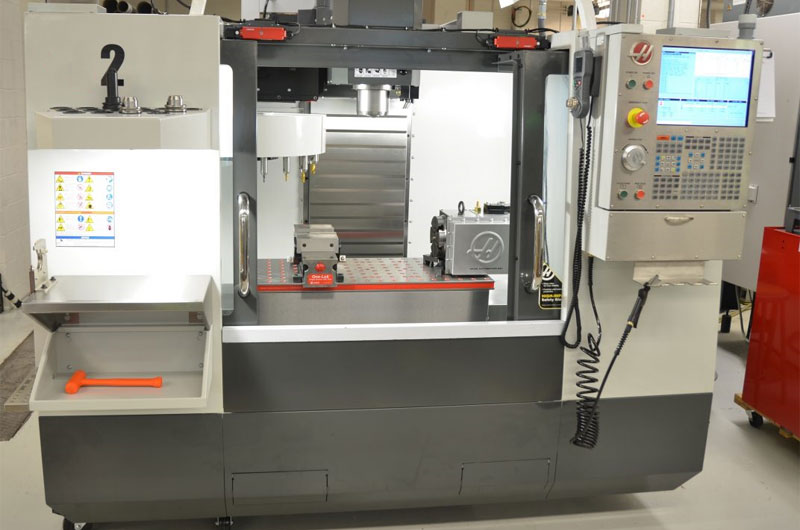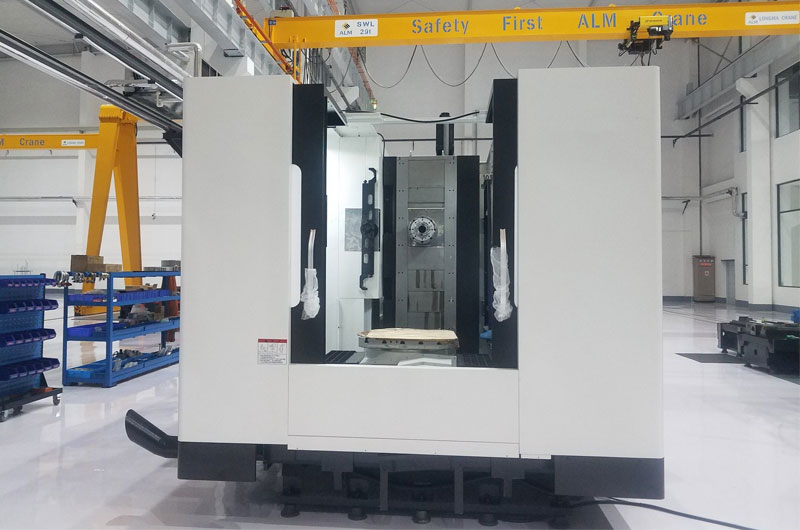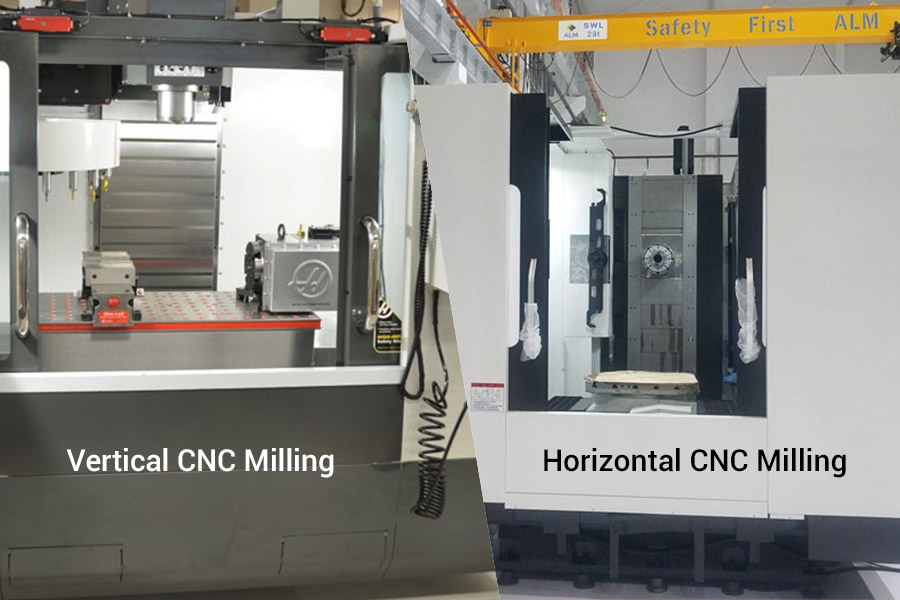CNC milling is a crucial process in modern manufacturing, providing precision, automation, and flexibility across industries such as aerospace, automotive, medical devices, and electronics.
As manufacturing demands grow, choosing between vertical and horizontal CNC milling machines becomes crucial. Each offers unique strengths, and productivity varies based on the task.
This article explores the key differences between vertical and horizontal CNC milling, focusing on their productivity, advantages, disadvantages, and applications in modern manufacturing.
What is Vertical CNC Milling?

The cutting tool is held in place by a vertical spindle in CNC milling machines. In order to remove material from the workpiece, the cutting tool travels vertically after being fastened to the machine table.
The machine’s design allows the operator to easily monitor the milling process, making it ideal for detailed and intricate work.
Advantages of Vertical CNC Milling
- Ease of Use: Vertical mills are generally more user-friendly, making them ideal for small to medium production runs and prototyping.
- Lower Cost: Vertical mills tend to be more affordable, which makes them a popular choice for smaller shops and manufacturers with limited budgets.
- Compact Design: Vertical mills require less floor space, making them suitable for workshops with space constraints.
Disadvantages of Vertical CNC Milling
- Limited Flexibility: Vertical milling machines are less suited for heavy, large-scale production, particularly when complex geometries are involved.
- Chip Removal: Vertical orientation means that gravity causes chips to fall on the workpiece, which can interfere with the cutting process and slow down productivity.
What is Horizontal CNC Milling?

Horizontal CNC milling machines feature a horizontally-oriented spindle and use a rotary table that moves the workpiece in relation to the cutting tool. This setup allows for more extensive material removal in fewer passes and is better suited for larger, heavier workpieces.
Horizontal milling machines are typically more robust, with higher torque and horsepower, making them ideal for heavy-duty tasks.
Advantages of Horizontal CNC Milling
Increased Productivity: Horizontal mills are highly efficient for cutting larger parts and handling bulk production. The machine’s design allows for faster material removal, which can significantly boost productivity.
- Improved Chip Evacuation: Gravity helps in chip removal, keeping the cutting area clear and improving the efficiency and precision of the machining process.
- Complex Workpieces: Horizontal mills can work on multiple sides of a workpiece without repositioning, making them ideal for complex geometries and 3D shaping.
- Better Surface Finish: Horizontal milling often results in a better surface finish due to the more stable configuration and efficient chip evacuation.
Disadvantages of Horizontal CNC Milling
- Higher Cost: Purchasing and maintaining horizontal mills is typically more expensive, which prevents smaller enterprises from using them.
- Greater Footprint: Horizontal machines require a greater amount of floor area, which may be prohibitive in smaller operations.
Main Distinctions
While both vertical and horizontal CNC milling machines serve the same basic purpose—removing material to shape a workpiece—their configurations and specific strengths differ significantly.
| Feature | Vertical CNC Milling | Horizontal CNC Milling |
| Spindle Orientation | Vertical spindle, moving along the Z-axis | Horizontal spindle, moving along the X-axis |
| Best For | Prototyping, small to medium production runs | High-volume production, complex geometries |
| Material Removal Rate | Slower, more suitable for detailed work | Faster material removal due to high torque and horsepower |
| Chip Removal | Chips accumulate on the workpiece, requiring manual removal | Efficient chip evacuation due to gravity |
| Surface Finish | Can be rougher due to chip accumulation and instability | Typically smoother due to stable configuration |
| Cost | Reduced starting cost, appropriate for lower budgets | More expensive at first but more productive in large-scale manufacturing |
| Workpiece Size | Limited to smaller workpieces | Ideal for larger, heavier parts |
| Footprint | Smaller, more compact design | Larger, requires more space |
Productivity Considerations
When comparing productivity in vertical and horizontal CNC milling, the type of project plays a significant role in determining which machine will be more effective. Here are some productivity factors to consider:
Material Removal Rate (MRR)
Horizontal CNC milling machines generally offer a higher material removal rate due to their higher torque and ability to cut on multiple sides of a workpiece. This increases the productivity of horizontal milling for applications requiring the rapid removal of huge amounts of material.
Downtime
Vertical CNC mills typically require more downtime for chip removal and workpiece repositioning, especially when working on complex geometries. Conversely, the advantages of horizontal mills include the flexibility to work on many sides of a part without stopping and repositioning, as well as gravity-assisted chip evacuation.
Flexibility vs. Specialization
Vertical mills are more versatile for a wide range of applications, particularly when the production involves frequent changes in setups or different part designs. Horizontal mills, however, excel in tasks requiring precision on large, complex parts and are best suited for high-volume production.
Operator Involvement
Vertical mills typically involve more operator oversight, especially for tasks requiring intricate detail. Horizontal mills, being more automated and designed for continuous operation, reduce the need for constant operator input, increasing overall throughput.
Applications
Both vertical and horizontal CNC milling machines have distinct applications depending on the type of work being done:
Vertical CNC Milling Applications
- Prototyping: Vertical mills are ideal for small-batch production and prototyping, where flexibility and ease of setup are priorities.
- Tool and Die Manufacturing: Vertical CNC mills can handle the precision work required for tools, dies, and molds.
- Artistic and Custom Work: For small shops producing artistic, decorative, or custom-designed pieces, vertical mills are more cost-effective and easier to manage.
Horizontal CNC Milling Applications
- Automotive Manufacturing: Horizontal mills are preferred for high-volume production of large automotive components, such as engine blocks and transmission housings.
- Aerospace: The ability to machine complex, large parts with precision makes horizontal milling ideal for aerospace components like wing spars and structural supports.
- Heavy Industry: Industries requiring the production of large, heavy parts, such as the oil and gas or shipbuilding sectors, rely heavily on horizontal CNC milling.
Which is More Productive?
When it comes to productivity, the choice between vertical and horizontal CNC milling depends largely on the specific requirements of the task at hand. For smaller-scale production and prototyping, vertical CNC mills are the best option because of their adaptability, simplicity of use, and reduced initial costs.
However, horizontal CNC mills dominate in terms of productivity for larger, more complex parts, high-volume production, and faster material removal rates.

